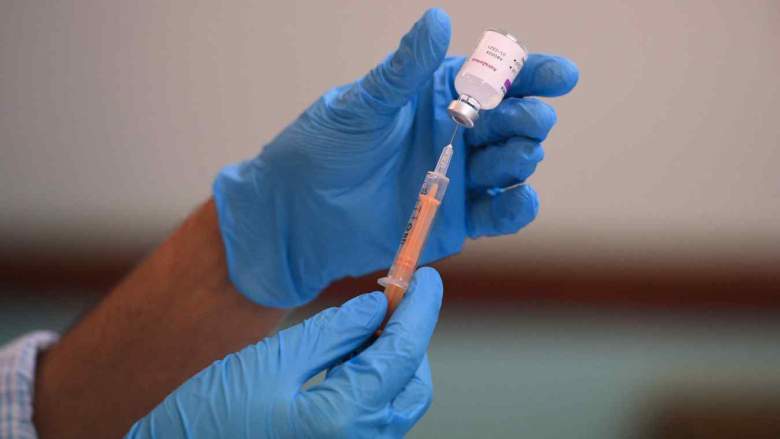
The AstraZeneca vaccine has been paused for younger demographics in several countries due to blood clotting concerns, and the FDA and CDC just called for the Johnson & Johnson COVID-19 vaccine to be temporarily paused as the same potential rare side effect is researched. Here’s a look at which COVID-19 vaccines are based on adenovirus vectors.
Here Are the COVID-19 Vaccines that Use Adenovirus Vectors
Both Johnson & Johnson’s vaccine and the AstraZeneca/Oxford vaccine use adenovirus vectors. Johnson & Johnson’s vaccine utilizes an Ad26 vector (a human adenovirus) believed to have less natural immunity in the population, Children’s Hospital of Philadelphia reported. The AstraZeneca/Oxford vaccine (called Covishield in India) uses a chimpanzee-based vector called ChAdOx1. This same vector was used in a 2018 trial on 24 people for a MERS vaccine, CEN reported.
Russia’s Sputnik V vaccine uses Ad26 for its first dose, followed by Ad5 for its second dose, Children’s Hospital of Philadelphia reported.
China’s CanSino Biologics also has an adenovirus vector vaccine for COVID-19, CEN reported. This uses the Ad5 vector, which has in the past brought up questions about effectiveness since many humans have some pre-existing immunity to that particular adenovirus strain.
ImmunityBio is developing an adenovirus-vector vaccine based on Ad5. They are conducting a trial using a combination of an oral vaccine and an under-the-tongue vaccine. Some hope that Ad5 delivered this way might have less of an issue with pre-existing immunity in the population.
Altimmune, Stabilitech BioPharma, and Vaxar are testing Ad5 vaccines using nasal sprays or pills, CEN reported. Altimmune’s AdCOVID is adenovirus-based but is delivered intranasally. On March 15, the results from a transgenic mouse model were announced from a preclinical trial.
ReiThera (once called Okairos) is testing a COVID-19 vaccine using a gorilla-derived adenovirus vector, CEN reported. This GRAd-COV2 vaccine candidate just started its Phase 2/3 clinical study on March 18. The study is named COVITAR.
Other Vaccines that Use Adenovirus Vectors
Adenovirus-based vaccines use the adenovirus as a vector to deliver an antigen. In the case of Johnson & Johnson’s vaccine, part of the adenovirus’s genetic instructions are replaced with coronavirus genes for making the spike protein. When injected, the cells make the spike protein on their own surface, teaching your immune system to recognize the spike proteins and create antibodies against them. The spike protein can’t cause COVID-19 by itself, and the adenovirus vector can’t replicate.
This isn’t the first time that adenoviruses have been used as vectors for vaccines and vaccine trials. The adenovirus was first used as a form of genetic therapy in the 1990s, but this was stopped after a teen boy died from the therapy in 1999 due to massive inflammation. Although this inflammation was harmful for gene therapy, scientists determined it could be helpful for vaccine delivery, CEN reported.
However, another concern with adenovirus vectors is that humans may have pre-existing immunity to certain strains or develop it after the first dose. This is less of a concern with chimpanzee-based adenovirus vectors used in some vaccines, Clinical Trials Arena reported.
The concern has played out in the past. Merck & Co. tested an HIV vaccine using an Ad5-based adenovirus vector. Because humans had a pre-existing immunity to this vector, the trials were halted in 2007 when it became known that the vaccines didn’t work or might even increase the risk of infection, CEN reported.
CanSino later developed an Ebola vaccine using an Ad-5 vector, which was approved by China in 2017 for emergency use only. There was still concern that pre-existing immunity to that particular vector might hurt that vaccine’s effectiveness, CEN reported.
Johnson & Johnson uses an adenovirus vector for its Ebola vaccine, Reuters reported. The vaccine was rolled out in the eastern Congo in 2019 for its first real-world setting after passing clinical trials. The vaccine required two injections about eight weeks apart. The first uses Janssen’s AdVac technology (Ad26) for the vector, which is the same that’s used for the COVID-19 vaccine, Johnson & Johnson shared. The second dose utilizes a different vector from MVA-BN technology. J&J has also been working on vaccines for RSV, Zika, and HIV using the Ad26 vector, CEN reported. These also use a booster shot with a different vaccine.
Adenovirus vector vaccines are also being researched for HIV, the flu, and Zika vaccines, the CDC reported.
Okairos has developed a chimpanzee-based adenovirus vector vaccine for malaria, CEN reported. Oxford has done the same with its own chimpanzee vector (ChAdOx1) and is testing it for MERS, AIDS, malaria, and tuberculosis. The MERS vaccine was tested on 24 people in a trial, showing elevated antibodies in people who got the highest dose.
READ NEXT: The latest COVID-19 deaths, cases, and updates